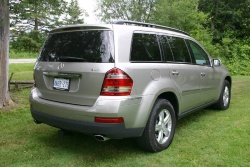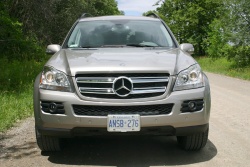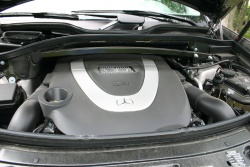|
Test Drive: 2007 Mercedes-Benz GL 450
Manufacturer’s web site |
By Chris Chase
Photos by Jil McIntosh
Mercedes-Benz introduced the GL-Class SUV in 2007, intending it as a replacement for the blocky G-Class. That truck wound up sticking around, but it didn’t much matter. The seven-passenger GL was a much different beast, being a more modern interpretation of a large, family-friendly crossover, based on the smaller M-Class, and built more for use on-road than off. Mercedes’ crossovers have a reputation for being capable performers in less than optimal conditions, however, particularly when optioned with the off-road package that was offered in the GL.
 2007 Mercedes-Benz GL 450. Click image to enlarge |
A 2007 GL-Class could be ordered with a 3.0L turbodiesel V6 (GL 320 CDI; 215 hp/398 lb-ft) or a 4.6L gasoline V8 (GL 450; 335 hp/339 lb-ft). Both were paired with a seven-speed automatic transmission and Benz’s 4Matic all-wheel drive system.
Standard stuff included Airmatic self-levelling air suspension, automatic climate control, heated synthetic leather seats, sunroof, park assist and power-folding third-row seats. The diesel model added a heatable, power-adjustable steering column and power-folding exterior mirrors. Options included leather upholstery, steerable xenon headlights, an off-road package with adaptive damping, navigation, power liftgate, three-zone climate control, three-row side airbags (the base model covered just the front and second rows), three-zone climate control, and a rear-seat DVD player.
Mercedes added a third model for 2008—the GL 550, named for its 5.5 L V8 engine, which made 382 hp and 391 lb-ft of torque. The GL 450 gained standard power steering column, power-folding mirrors, heated steering wheel, steerable xenon headlights, leather and larger wheels. The GL 550 got standard adaptive damping, navigation, and aluminum running boards.
 2007 Mercedes-Benz GL 450. Click image to enlarge |
2009 models were fitted with new audio and communications systems, and the diesel engine got Benz’s Bluetec technology, which used urea injection to help the engine meet more stringent emissions regulations. Also, all models got a four-way lumbar adjustment, new mirrors and steering wheel, and a driver’s knee airbag.
The GL got a facelift, inside and out, in 2010, and the diesel model was renamed the GL 350 Bluetec, though the engine was carried over from the previous year. That model also gained standard headlamp washers and steerable xenon headlights.
In 2011, all Premium option packages added blind-spot monitoring, and the GL 350 and 450 got LED daytime running lights and 20-inch wheels with run-flat tires, and a new Sport package added 21-inch wheels and tires and adaptive damping.
For 2012, the GL 450 was discontinued, the GL 350 got an optional Premium Seating package, and limited paint colours were available.
Believe it or not, fuel economy is a concern in luxury vehicles; even those who can afford to own something this big wince at a $100+ fill-up. That’s the appeal of the diesel-powered GL-Class, whose Natural Resources Canada fuel consumption estimates were 11.6/8.5 L/100 km (all figures city/highway) in 2007. Compare those figures to the GL 450’s ratings of 16.3/11.7 L/100 km. That’s exactly why Mercedes sells as many diesels as it does.
 2007 Mercedes-Benz GL 450. Click image to enlarge |
Surprisingly, the addition of urea injection in 2009 didn’t improve the diesel’s fuel economy; in fact, it made it a bit worse, with consumption rising to 12.4/8.8 L/100 km.
The big 5.5L motor in the GL 550 was thirstiest of all, with ratings of 17.1/11.9 L/100 km.
Jil McIntosh tested a Benz GL 450 in 2007, and drove it to an (impressive) real-world average of 12.7 L/100 km, in mostly highway driving.
Consumer Reports gives a used GL a “worse than average” used vehicle rating; TrueDelta.com suggests a repair frequency higher than the average for the upscale large SUV class. Click through to page two for details on what tends to go wrong in these big crossovers.











